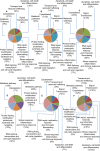Proteomic-based approach to gain insight into reprogramming of THP-1 cells exposed to Leishmania donovani over an early temporal window
- PMID: 25690103
- PMCID: PMC4399049
- DOI: 10.1128/IAI.02833-14
Proteomic-based approach to gain insight into reprogramming of THP-1 cells exposed to Leishmania donovani over an early temporal window
Abstract
Leishmania donovani, a protozoan parasite, is the causative agent of visceral leishmaniasis. It lives and multiplies within the harsh environment of macrophages. In order to investigate how intracellular parasite manipulate the host cell environment, we undertook a quantitative proteomic study of human monocyte-derived macrophages (THP-1) following infection with L. donovani. We used the isobaric tags for relative and absolute quantification (iTRAQ) method and liquid chromatography-tandem mass spectrometry (LC-MS/MS) to compare expression profiles of noninfected and L. donovani-infected THP-1 cells. We detected modifications of protein expression in key metabolic pathways, including glycolysis and fatty acid oxidation, suggesting a global reprogramming of cell metabolism by the parasite. An increased abundance of proteins involved in gene transcription, RNA splicing (heterogeneous nuclear ribonucleoproteins [hnRNPs]), histones, and DNA repair and replication was observed at 24 h postinfection. Proteins involved in cell survival and signal transduction were more abundant at 24 h postinfection. Several of the differentially expressed proteins had not been previously implicated in response to the parasite, while the others support the previously identified proteins. Selected proteomics results were validated by real-time PCR and immunoblot analyses. Similar changes were observed in L. donovani-infected human monocyte-derived primary macrophages. The effect of RNA interference (RNAi)-mediated gene knockdown of proteins validated the relevance of the host quantitative proteomic screen. Our findings indicate that the host cell proteome is modulated after L. donovani infection, provide evidence for global reprogramming of cell metabolism, and demonstrate the complex relations between the host and parasite at the molecular level.
Copyright © 2015, American Society for Microbiology. All Rights Reserved.
Figures









Similar articles
-
SILAC-based quantitative proteomics reveals pleiotropic, phenotypic modulation in primary murine macrophages infected with the protozoan pathogen Leishmania donovani.J Proteomics. 2020 Feb 20;213:103617. doi: 10.1016/j.jprot.2019.103617. Epub 2019 Dec 14. J Proteomics. 2020. PMID: 31846769
-
Comprehensive proteomic analysis of autophagosomes derived from Leishmania-infected macrophages.PLoS One. 2023 Apr 7;18(4):e0284026. doi: 10.1371/journal.pone.0284026. eCollection 2023. PLoS One. 2023. PMID: 37027358 Free PMC article.
-
Leishmania donovani targets tumor necrosis factor receptor-associated factor (TRAF) 3 for impairing TLR4-mediated host response.FASEB J. 2014 Apr;28(4):1756-68. doi: 10.1096/fj.13-238428. Epub 2014 Jan 3. FASEB J. 2014. PMID: 24391131
-
In Search of Biomarkers for Pathogenesis and Control of Leishmaniasis by Global Analyses of Leishmania-Infected Macrophages.Front Cell Infect Microbiol. 2018 Sep 19;8:326. doi: 10.3389/fcimb.2018.00326. eCollection 2018. Front Cell Infect Microbiol. 2018. PMID: 30283744 Free PMC article. Review.
-
Survival strategies of Leishmania donovani in mammalian host macrophages.Res Immunol. 1998 Sep-Oct;149(7-8):689-92. doi: 10.1016/s0923-2494(99)80040-6. Res Immunol. 1998. PMID: 9851525 Review.
Cited by
-
Global analysis of glycoproteins identifies markers of endotoxin tolerant monocytes and GPR84 as a modulator of TNFα expression.Sci Rep. 2017 Apr 12;7(1):838. doi: 10.1038/s41598-017-00828-y. Sci Rep. 2017. PMID: 28404994 Free PMC article.
-
Using Proteomics to Understand How Leishmania Parasites Survive inside the Host and Establish Infection.Int J Mol Sci. 2016 Aug 19;17(8):1270. doi: 10.3390/ijms17081270. Int J Mol Sci. 2016. PMID: 27548150 Free PMC article. Review.
-
Leishmania infection upregulates and engages host macrophage Argonaute 1, and system-wide proteomics reveals Argonaute 1-dependent host response.Front Immunol. 2023 Nov 30;14:1287539. doi: 10.3389/fimmu.2023.1287539. eCollection 2023. Front Immunol. 2023. PMID: 38098491 Free PMC article.
-
Epigenetic regulation of defense genes by histone deacetylase1 in human cell line-derived macrophages promotes intracellular survival of Leishmania donovani.PLoS Negl Trop Dis. 2020 Apr 10;14(4):e0008167. doi: 10.1371/journal.pntd.0008167. eCollection 2020 Apr. PLoS Negl Trop Dis. 2020. PMID: 32275661 Free PMC article.
-
Chromatin-Remodeling Factor BRG1 Is a Negative Modulator of L. donovani in IFNγ Stimulated and Infected THP-1 Cells.Front Cell Infect Microbiol. 2022 Apr 1;12:860058. doi: 10.3389/fcimb.2022.860058. eCollection 2022. Front Cell Infect Microbiol. 2022. PMID: 35433496 Free PMC article.
References
-
- Herwaldt BL. 1999. Leishmaniasis. Lancet 354:1191–1199. - PubMed
Publication types
MeSH terms
Substances
LinkOut - more resources
Full Text Sources
Other Literature Sources

